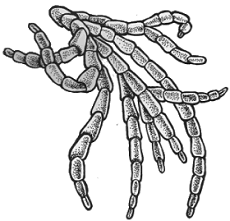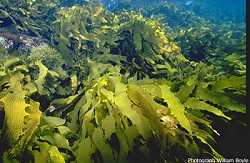 |
|

|
Marine
algae
courtesy
Great Barrier Reef Marine Park Authority
|
| The
Great Barrier Reef is home to more than
500 species of marine plants known as
algae. Algae have been part of the marine
ecosystem for more than two billion
years. Marine algae generally come in
brown, red or green forms. Although
they are classified as plants, they
lack the roots, stems and true leaves
of land plants. Larger algae are commonly
referred to as seaweed. Like other plants,
algae rely on sunlight to internally
manufacture food and grow.
Many marine algae contribute to the
Reef's overall structure. By growing
between coral fragments and rubble,
coralline algae help to bind the Reef
together. Limestone-producing algae
also make up a major component of
the Reef's sand when they die and
breakdown. Plankton algae have an
important role in nutrient cycling
in Reef waters. Inshore reefs often
have an abundance of algae on them.
Marine plants dominate the Reef as
nutrient cyclers, builders, binders
and sediment producers.
|

Drawing
courtesy Wet
Paper |

Giant
kelp forests found off the coast
of South
Australia, Victoria and Tasmania
are rainforests
of the sea, growing up to 30 metres
above the
seabed. They provide shelter for
many fish and
invertebrate species like lobsters
and abalone.
Photograph courtesy Parks Victoria
|
There are several major categories
of algae. In general terms, they
relate to the colour of the algae
and include:
Blue-green
algae are microscopic and
can form a reddish slick on
the water's surface (often called
red tide) and are common in
Reef waters following calm weather.
Blue-green algae may also form
blue-grey slimey areas on the
coral reef surface.
Red
algae are the most common
larger algae found in coral
reef environments. They include
calcareous types, which form
a hard coating on the Reef surface.
The algae usually grow in shaded
areas or under coral rubble.
They have a major role in cementing
the reef structure together.
Brown
algae are abundant in cooler
climates, such as in kelp beds,
however a few species can be
commonly found in the tropics
on inshore reefs. At some sites
and times, these large algae
may shade adjacent corals so
they cannot be seen easily.
|
| Zooxanthellae
are also a type of algae and are
one of the most important organisms
on the Reef. Zooxanthellae are
tiny plants that live within the
tissue of many marine animals,
such as corals, directly providing
them with their nutritional requirements.
Zooxanthellae are essential for
corals to survive and grow, building
the structure of corals reefs. |
|
Some damselfish farm algae
on coral heads for food.
The fish nip the coral
to create cuts that encourage
the algae to grow.
|
|
|
Nutrients provide food for marine
algae and help them to survive,
grow and reproduce. The increased
nutrients being released onto
the Great Barrier Reef through
run-off from coastal development
and human activity may have
led to an increase in the amount
of marine algae in several areas
of the Marine Park. These 'over-fed'
algae can out-compete corals,
robbing them of the light they
need to survive. They can also
adversely affect seagrass in
a similar way.
Marine algae can be affected
by natural events such as cyclones,
and from human impacts such
as land run-off and habitat
disturbance. The major impact
on algae is water quality change
caused by land use and agricultural
practices adjacent to the Great
Barrier Reef .
|
|
|
|
|
|
|
